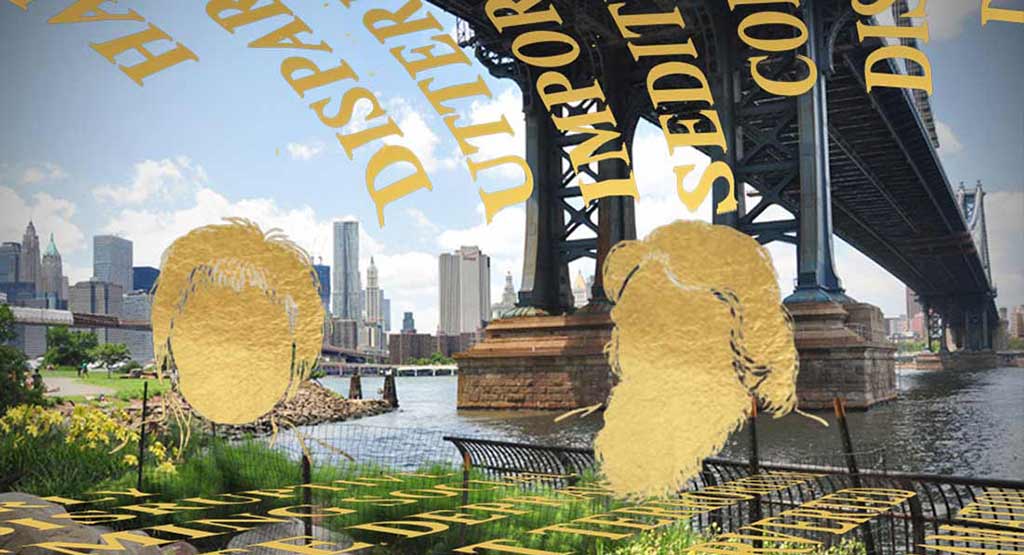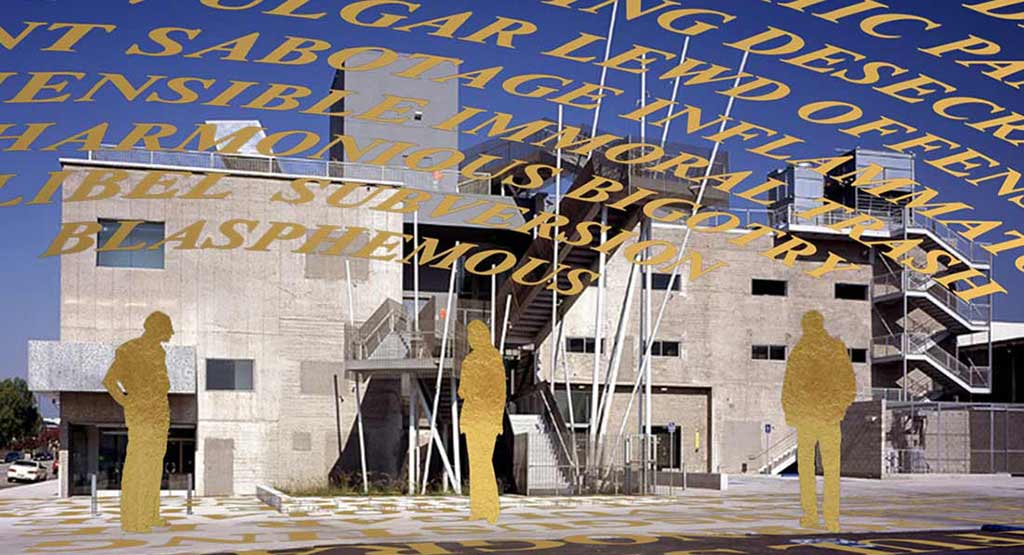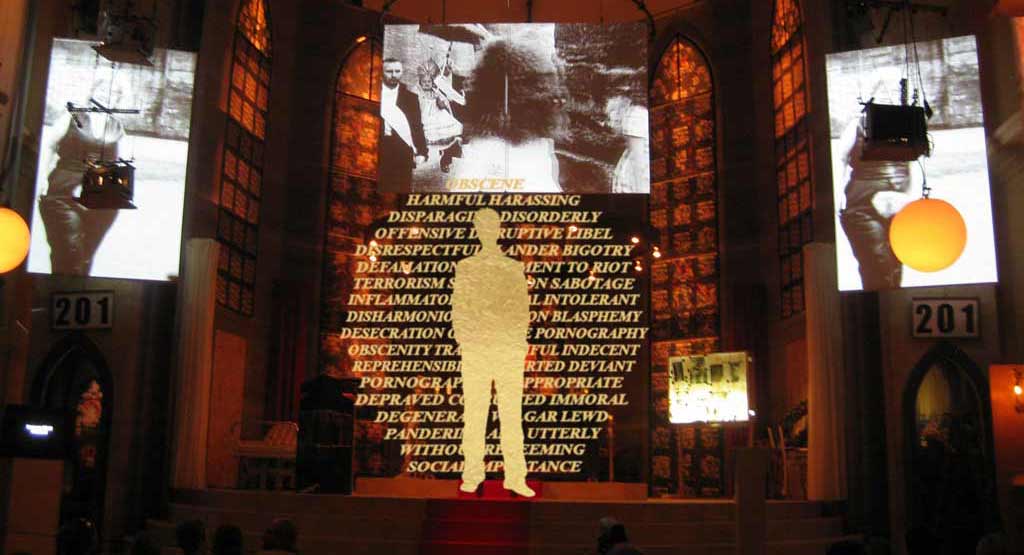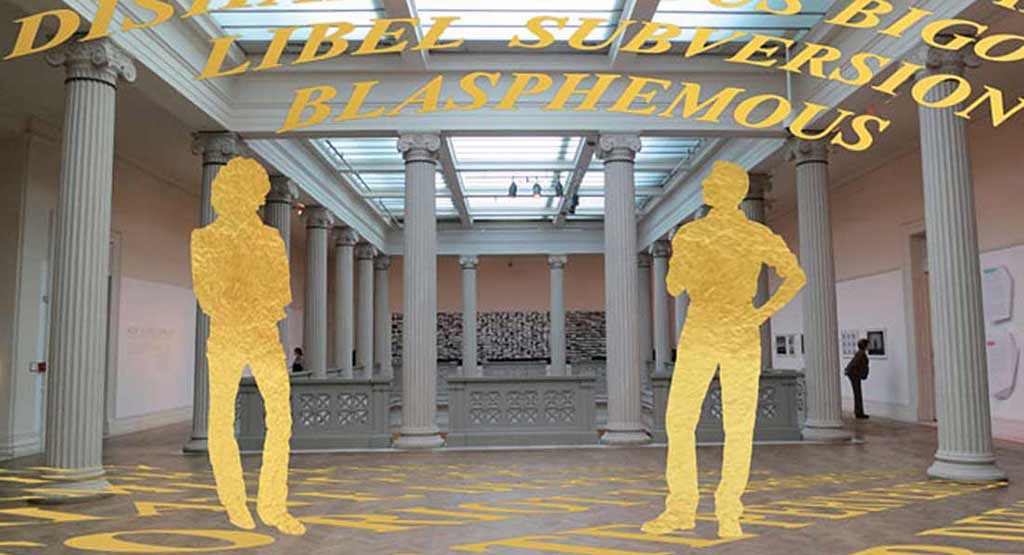Shades of Absence

Shades of Absence: Outside Inside
(Location in Venice: Giardini main concourse, in front of the Central Pavilion)Augmented reality installation, developed for an intervention into the 2011 Venice Biennale. By Tamiko Thiel
"Shades of Absence: Outside Inside" focuses on artists who have faced threats of arrest or violence. Placed in the Giardini main concourse, in this augmented reality (AR) artwork gold silhouettes of artists' faces hover in a virtual pavilion that is formed by terms of transgression used to justify censorship. Some are art world insiders and international stars, others are known only within their own circles. The faces are only a tiny fraction of the many artists worldwide who face arrest or physical violence and are anonymized to represent the many censored artists who do not enjoy widespread public support for their cases.
Below are some examples; I would appreciate hearing of other recent cases (from this century) in the Facebook group "Shades of Absence" or via email at shadesofabsence@gmail.com.
Disclaimer: I do my best to check facts, but do not guarantee 100% accuracy. The content and opinions expressed by the artists in their works are their own and do not necessarily represent mine, but it is important that their cases are known and can be discussed in public - without fear of arrest or violence.
- Ahmed Basiony, in Egypt
From Nafas Art Magazine: "On January the 28th, Ahmed Basiony died of gunshot wounds inflicted by snipers from the Egyptian Police Forces on Tahrir Square during the start of the 25 January 2011 revolution."
[ article ] - Tangerine, in Hong Kong
In May 2011 street artist Tangerine (Tang Chin) is being investigated on criminal damage charges for spray-painting stencils of Ai Weiwei with the text, "Who's afraid of Ai Weiwei?" If convicted, she could receive up to 10 years in prison.
[ article/images ] - Bedri Baykam / Tugba Kurtulmus / Mehmet Aksoy, in Turkey
In April 2011 painter Bedri Baykam and his assistant Tugba Kurtulmus were stabbed in Istanbul after attending a meeting to discuss a protest march ain support of Mehmet Aksoy, whose sculpture "Monument to Humanity" is being torn down in Kars, Turkey.
[ article ] - Ai Weiwei, in China
In April 2011 Ai was arrested in Beijing for "economic crimes". In January 2011 Ai's studio in Shanghai had been demolished as an "illegal building". In August 2009 Ai and 10 of his helpers were beaten by the police in Chengdu for supporting investigations into the deaths of schoolchildren during the 2008 earthquake.
[ article ] - Andres Serrano, in France, Sweden, Australia, USA
In April 2011 Serrano's photograph "Piss Christ" was attacked with hammers and destroyed after an "anti-blasphemy" campaign by French Catholic fundamentalists in Avignon, France. Serrano's works have been previously vandalized in Sweden in 2007 and Australia in 1997, and gallerists and museums have received death threats for exhibiting the work. In 1989 "Piss Christ" was at the center of a controversy in the USA about public funding for the arts.
[ article ] - M.F. Husain, in India
In 2010 Husain accepted Qatar citizenship, after over a decade of legal harassment and physical threats in his native India for painting nude Hindu deities. M.F. Husain died on June 9, 2011 in a London hospital.
[ article ] - Owen Maseko, in Zimbabwe
Police arrested Maseko in 2010 for "undermining the authority of the president" Mugabe and confiscated his artworks on the Gukurahundi military offensive against Ndebele civilians in the 1980s.
[ article ] - Sally Mann, in Finland
In 2008 requests were made to the Helsinki Police Department to investigate whether Mann's photographs, shown an exhibit in Helsinki, were "an offence against human dignity." Various of Mann's photographs of children have been controversial in many countries, including the USA, since being first published in 1988.
[ article ]
- Wafaa Bilal, in the USA
In 2008 Bilal's installation "Night of Bush Capturing: Virtual Jihadi" was censored by the Rensselaer Polytechnical Institute under threat of an F.B.I. investigation of Bilal as a threat to national security.
[ article ] - Steve Kurtz, Critical Art Ensemble, in the USA
In 2004 the F.B.I. arrested Steve Kurtz on suspicion of bioterrorism for possession of biological specimens of harmless bacteria. He was indicted on federal criminal mail fraud and wire fraud charges, which under the USA Patriot Act would carry a sentence of 20 years in prison. In 2008 he was cleared of all charges.
[ C.A.E defense fund website ] - Dimitrios Fotiou, in Greece
Fotiou was arrested in Greece in 2005 as his netproject "Illegal Machines" was considered a financial crime.
[ article ] - Liu Bolin, in China
In 2005 Liu's Beijing studio was shut down by the authorities. He began his artwork series "Hiding in the City" as a reaction to this event.
[ images ] - Soudabeh Ardavan, in Iran
In 2002 Ardavan published for the first time drawings she had made while in Evin Prison from 1981-1989. She had been accused of taking part in a demonstration.
[ article/images ]

Shades of Absence: Public Voids
(Location in Venice: Piazza San Marco) Augmented reality installation, developed for an intervention into the 2011 Venice Biennale. ByTamiko Thiel"Shades of Absence: Public Voids" calls attention to a few cases of censorship of public art around the world. I would appreciate hearing of other recent cases (from this and the previous century) in the Facebook group "Shades of Absence" or via email at shadesofabsence@gmail.com.
Disclaimer: I do my best to check facts, but do not guarantee 100% accuracy. The content and opinions expressed by the artists in their works are their own and do not necessarily represent mine, but it is important that their cases are known and can be discussed in public - without fear of arrest or violence.
- Mehmet Aksoy, Monument to Humanity” in Kars, Turkey 2011
The giant monument to friendship between Turkey and Armenia near the border between the two countries became a symbol of controversy after Prime Minister Recep Tayyip Erdoğan called it “freakish.” The Kars municipality decided to demolish the controversial statue, saying it was illegally
erected in a protected area.
[ image/article ] - Mustapha Benfodil, "It has no importance/Wild Writings", Sharjah Biennial, U.A.E. 2011
An installation consisting of mannequins in soccer uniforms emblazoned with Arabic phrases that were deemed blasphemous.
[ artist's statement ] [ images ] - Emily Jacir and Yazid Anani , “Al Riyadh”, in the exhibit “Ramallah- the fairest of them all?”, Palestine 2010
The Ramallah Municipality physically removed two billboards created by artists Emily Jacir and Yazid Anani claiming that the works were “problematic”. The works were critical of the recent proliferation of gated communities.
[ article ]
Emily Jacir and Yazid Anani, "stazione", Palestine c/o Venice collateral event of the Venice Biennial, Italy 2009
The names of each vaporetto station were to be written in Arabic as well as Italian. The project was stopped without a clear explanation why.
[ interview ] [ Images]
- Inass Yassin, “Ebi foq il Shajara”, in the exhibit “Ramallah- the fairest of them all?”, Palestine 2010
Unknown people removed hundreds of Yassin's posters less then 24 hours after she hung them. The posters were re-prints of a film from 1971, showing the lead actors about to kiss.
[ article - scroll down for Yassin] - Jacques Charlier, "100 Sexes d'Artistes", public artwork for the Venice Biennial, Italy 2009
Imaginary portraits of the sexual organs of well-known international artists was denied permission to be shown as public posters for fear of offending the artists so portrayed.
[ image/article ] - James Powderly, "Free Tibet", Beijing, China 2008
Powderly and other members of the New York City artist community were arrested in Beijing for planning in collaboration with Students for a Free Tibet to project a laser-powered stencil on a building near Tian-an-men Square with the words “Free Tibet”.
[ interview ]
- Gregor Schneider, "Cube Venice 2005", public artwork in Piazza San Marco for the Venice Biennial, Italy 2005
A cube of aluminum scaffolding draped in black muslin was to be installed in Piazza San Marco, an evocation of the Kaaba in Mecca as a reference to the Venice's historic connections to Islamic culture. The city denied permisson for fear of offending the Muslim community.
[ article ] [ Images ] - Justine Wollaston, "Eve", mural in Pilot Point, Texas, USA 2003
The painting, showed a nude female figure, was deemed "harmful to minors" by the City of Pilot Point. The owner of the building placed crime scene tape over the nipples of the figure and sued the city in return in 2005.
[ article on "Art on Trial" website]

Shades of Absence: Schlingensief Gilded
(Location: German Pavilion/Giardini)Augmented reality installation, developed for an intervention into the 2011 Venice Biennale. By Tamiko Thiel
A memorial to celebrate the canonization of Christoph Schlingensief by the Venice Biennial, a year after his death in 2010. There are probably many, many times when people wanted to censor Christoph Schlingensief.
Several cases when this actually happened:
- "Bathing in Lake Wolfgang", Lake Wolfgang/St. Gilgen, Austria, 1998
A performance as part of Schlingensief's CHANCE2000 political party for the 1998 German Parliment elections
As part of the Festival "Szene Salzburg" Schlingensief invited all 4 million unemployed Germans to come to bathe together in Lake Wolfgang, where German Chancellor Kohl had his summer house, in order to raise the water level enough to flood Kohl's house. Salzburg's mayor Josef Dechant threatened to cancel the Festival's funding, and the Festival gave in to the censorship. (The newspaper Berliner Zeitung calculated however that the water would have only risen 2 cm, not enough to flood Kohl's house.)
- "My Felt, My Fat, My Hare, 48 Hours Survival for Germany", Dokumenta X, Kassel, Germany, 1997
During this performance Schlingensief and the actor Bernhard Schütz were arrested by the police for a poster titled "Kill Helmut Kohl" (the German Chancellor at that time).
- He was also arrested in 1996 in Zimbabwe, while working on the film United Trash. If you know more about this incident, please enter it into the Facebook page "Shades of Absence" or email me at shadesofabsence@gmail.com.

Shades of Absence: Governing Bodies
Locations:- Corcoran Gallery of ARt and Corcoran College of ARt and Design, Washington D.C.
- National Endowment of the ARts offices, in the Old Post Office Pavilion.
- United States Capitol Building, including House and Senate Chambers.
- New Museum, New York, NY, where the NEA 4 were in residence for the show “NYC 1993: Experimental Jet Set, Trash and No Star”
In "Shades of Absence: Governing Bodies" figures of artists who have been censored or come under attack by high government officials in the USA are anonymized as gold silhouettes, and stand amongst terms of censorship as representatives of the multitudes of artists whose work has been attacked in similar ways.
To view this webpage on a PC, go to https://mission-base.com/tamiko/AR/sa/shades-censoredArtists.html
Government censorship spanning the 20th and 21st centuries:
- Paul Cadmus
(1934, Corcoran Gallery of Art): [ US Navy website ] [ queer-arts.org website ] [ interview ]
In 1934, Secretary of the Navy Claude A. Swanson had a painting by Cadmus, "The Fleet's In!" removed from an exhibit in the Corcoran Gallery of Art in Washington D.C.. This Navy website chronicles the censorship and further career of the artwork. - Alexander Liberman
(1971, Corcoran Gallery of Art grounds): [ Photo: "Adam" ] [ WA Post article ]
The sculpture "Adam" was on display on the Corcoran Gallery grounds at the corner of 17th and New York NW. President Nixon could see it from the White House grounds and ordered his staff member Leonard Garment to see that it was removed. Garmet enlisted Nancy Hanks, then chairwoman of the National Endowment for the Arts, "to make it appear not as if the Corcoran was losing a work of art, but that another location was gaining a work of art." (See Washington Post article linked above.) - Robert Mapplethorpe
(1989, U Penn Institute of Contemporary Art, Corcoran Gallery of Art, Cincinnati Contemporary Arts Center):
[ WA Project for the Arts show ] [ Official website ]
An exhibition of Mapplethorpe's work was cited by Congress members as an example of use of government funds to support work they considered obsene:"The Institute of Contemporary Art at the University of Pennsylvania had used $30,000 of a visual arts grant it received from the NEA to fund a 1989 retrospective of photographer Robert Mapplethorpe’s work. The exhibit, entitled The Perfect Moment, included homoerotic photographs that several Members of Congress condemned as pornographic." (See the Opinion of the Court, NEA vs. Finley)
The exhibit was supposed to travel to the Corcoran Gallery of Art in Washington D.C., but the director Dr. Christina Orr-Cahall canceled the show in hopes of forestalling controversy, which created a storm of controversy on self-censorship of art institutions. The non-profit Washington Project for the Arts took over the show and exhibited it to record crowds.
Dennis Barrie, director of the Cincinnati Contemporary Arts Center, was later indicted but then acquitted in 1990 of obscenity charges for showing the exhibit as well. - Andres Serrano
(1989, Southeast Center for Contemporary Art): [ The Nation ] [ Artist's website ]
"Members also denounced artist Andres Serrano’s work Piss Christ, a photograph of a crucifix immersed in urine... Serrano had been awarded a $15,000 grant from the Southeast Center for Contemporary Art, an organization that received NEA support." (See the Opinion of the Court, NEA vs. Finley and comments by member of the Senate.) - David Wojnarowicz
(2010, Smithsonian Institution National Portrait Gallery) [ ppow Gallery - Estate of David Wojnarowicz ]
In 1989 Wojnarowicz's art was under attack from the religious right (he sued back and won). In 2010 Republicans John Boehner and Eric Cantor threatened the Smithsonian with withdrawal of funding if it did not remove Wojnarowicz's 1987 work “A Fire in My Belly" from a group show in the National Portrait Gallery. (See articles in Alternet and the NY Times.)
The NEA Four:
The National Endowment for the Arts was set up by the US Congress in 1965 as an independent agency of the federal government to fund the arts in the USA. In the "Culture Wars" around 1990 the NEA came under attack by members of Congress, led by Senator Jessie Helms, for funding certain artists and artworks. Under pressure from some of these members to completely abolish the NEA, Congress adopted the Williams/Coleman Amendment (20 U.S.C. § 954(d)(1)) requiring the NEA to take "into consideration general standards of decency" and " that obscenity is without artistic merit, is not protected speech, and shall not be funded." (I was not able to find a definition of "obscene" in the document, however.) The "NEA Four" were four artists whose projects were denied funding while this amendment was still under consideration by Congress. A common pattern in censorship cases is that an authority in the art world self-censors preemptively, in order to avoid controversy - which of course raises another controversy. See this article in People's Magazine (sic!) on the artists' reactions to the NEA denial of funding.
The NEA Four filed suit against the NEA claiming violation of their First Amendment rights as their applications were rejected on political grounds. The case went all the way up to the Supreme Court under the name "National Endowment for the Arts et al. versus Karen Finley et al. (524 U.S. 569)" and was decided in favor of the NEA in 1998. (See the Opinion of the Court, NEA vs. Finley, which mentions "homoeroticism" as being by definition obscene, and the dissent by Justice Souter. The full text of the decision is at www.supremecourt.gov/opinions/boundvolumes/524bv.pdf.)
The NEA 4 was in residence at the New Museum May-June 2013 as part of the show “NYC 1993: Experimental Jet Set, Trash and No Star.”
- Karen Finley [ wikipedia ]
- Holly Hughes [ Artist's website ]
- John Fleck [ Artist's website / video excerpts of performances ]
- Tim Miller [ Artist's website / video excerpt of "My Queer Body" ]